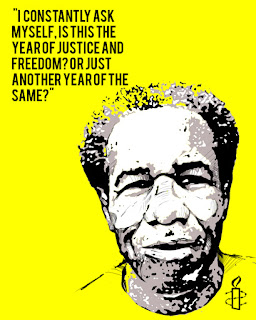Healing Our Wounds: Restorative Justice Is Needed For Albert Woodfox, The Black Panther Party & The Nation –Law Professor Angela A. Allen-Bell interviewed by Angola 3 News
On Monday, June 8, 2015, US District Court Judge James Brady ruled that the Angola 3’s Albert Woodfox be both immediately released and barred from a retrial. The next day, at the request of the Louisiana Attorney General, the US Fifth Circuit Court of Appeals issued a temporary stay of release set to expire on Friday, June 12.
As the week intensified following Judge Brady’s ruling, both Albert Woodfox and his family, friends & supporters wondered if he would finally be released over 43 years after first being placed in solitary confinement. Amnesty International USA launched a petition calling on Louisiana Governor Bobby Jindal to honor Judge Brady’s ruling.
On June 9, US Congressman Cedric Richmond (LA-02) issued a statement declaring that “Attorney General Caldwell must respect the ruling of Judge Brady and grant Mr. Woodfox his release immediately…This is an obviously personal vendetta and has been a waste of tax payer dollars for decades. The state is making major cuts in education and healthcare but he has spent millions of dollars on this frivolous endeavor and the price tag is increasing by the day.”
On June 11, eighteen members of the Louisiana House of Representatives voted unsuccessfully to pass a resolution (H.R. 208) urging Attorney General Caldwell to stop standing in the way of justice, withdraw his appeals, and let Judge Brady’s unconditional writ and release ruling stand.
However, on Friday, June 12, the Court responded by scheduling oral arguments for late August and extending the stay of release at least until the time that the Court issues its ruling later in the Fall.
Among those who communicated with Albert during that emotional week was Southern University Law Professor Angela A. Allen-Bell. In the days following Judge Brady’s ruling, she was a featured guest on several television and radio shows that focused on Albert’s case, including National Public Radio. In this interview with Angola 3 News, Prof. Bell discusses her new law journal article and reflects upon the latest developments in Albert’s fight for freedom. She argues that recent Angola 3-related media coverage in the US is becoming “more substantive,” and that this month “the media got bolder and began digging deeper than just a soundbite.”
Read the full interview here.
Albert Woodfox: The Beat Goes On
The Why Am I Not Surprised Blog has published a follow-up essay to They Call Me The Last Man Standing, featured in an earlier newsletter. In the new essay, the author writes:
“Last week, I wrote a post about what I hoped against hope would be our last visit before his being released after 43 years in solitary confinement. But the Appellate Court had other ideas. So I drove back up to the jail again Wednesday to spend another hour talking to him through a mesh grill.”
Read the full essay here.
New Yorker on “The Vindictiveness of the State”
David Cole of the New Yorker writes: “Louisiana authorities have never given any reason other than the original crime for keeping Woodfox in solitary confinement. On the few occasions in the past four decades when he has been temporarily housed with others, he has posed no real threat to them… The vindictiveness of the state is perhaps best illustrated in its treatment of Woodfox’s co-defendant, Herman Wallace. When Wallace’s conviction was also overturned on discrimination grounds in 2013, the judge in his case ordered his release, in view of the fact that Wallace was dying of liver cancer and had only days to live. Wallace was released on a Monday, and died on a Friday. He’d had three and a half days of freedom. Two days before he died, the prosecution reindicted him.”
Read the full article here.
The Vera Institute of Justice’s New Report On Solitary Confinement
“Segregated housing, commonly known as solitary confinement, is increasingly being recognized in the United States as a human rights issue. While the precise number of people held in segregated housing on any given day is not known with any certainty, estimates run to more than 80,000 in state and federal prisons-which is surely an undercount as these do not include people held in solitary confinement in jails, military facilities, immigration detention centers, or juvenile justice facilities. Evidence mounts that the practice produces many unwanted and harmful outcomes-for the mental and physical health of those placed in isolation, for the public safety of the communities to which most will return, and for the corrections budgets of jurisdictions that rely on it for facility safety. Yet solitary confinement remains a mainstay of prison management and control in the U.S. largely because many policymakers, corrections officials, and members of the general public still subscribe to some or all of the common misconceptions and misguided justifications addressed in this report. This publication is the first in a series on solitary confinement, its use and misuse, and ways to safely reduce it in our nation’s correctional facilities.”
Read the full report here.
US Congressman Cedric Richmond Writes About Solitary Confinement for Harvard University
Rep. Cedric Richmond, who for several years now has publicly called for justice for the Angola 3, also introduced the Solitary Confinement Study and Reform Act of 2014 to Congress. More recently, he published a policy essay on solitary for Harvard University’s John F. Kennedy School of Government Journal on Legislation, entitled “Toward a More Constitutional Approach to Solitary Confinement: The Case for Reform.”
Read the full article here.
Four years since our hunger strikes began, none of our core demands have yet been met: Our protracted struggle must continue
Mutope Duguma, from the Pelican Bay short corridor writes for the SF Bay View Newspaper: “2015 marks four years since we collectively got together and launched our peaceful protests to end long term solitary confinement. We have not been able to get any policy, outside of STG (Security Threat Group) 1 and 2 and SDP (Step Down Program), which we have to keep in mind is again CDCr continuing to violate our civil and human rights by holding men and women in these solitary confinement torture chambers – SCTC – indefinitely.”
Read the full article here.
Cialis online
Unity between races is going strong; be proud of yourselves! order misoprostol
Kendra Castaneda Perez, the wife of Raymond “Chavo” Perez, one of the 12-man body of representatives responsible for the historic Furosemide online Agreement to End Hostilities, writes for the SF Bay View:
“I am very proud of the Southern Mexicans and African Americans within the California prison system for how they have been able to put aside their differences and continue to peacefully unite together so strongly. Also, the violent past of the Southern Mexicans and Northern Mexicans that lasted for decades until the End of Hostilities was implemented in 2012 has shown progress toward unification. CDCr segregated the ‘Southerners’ and ‘Northerners’ away from each other in the years past.
Read the full article here.
For more updates on prison organizing in California, please visit the Prisoner Hunger Strike Solidarity website, here.
#72148
West Feliciana Parish Detention Center
PO Box 2727
St. Francisville, LA 70775
.


